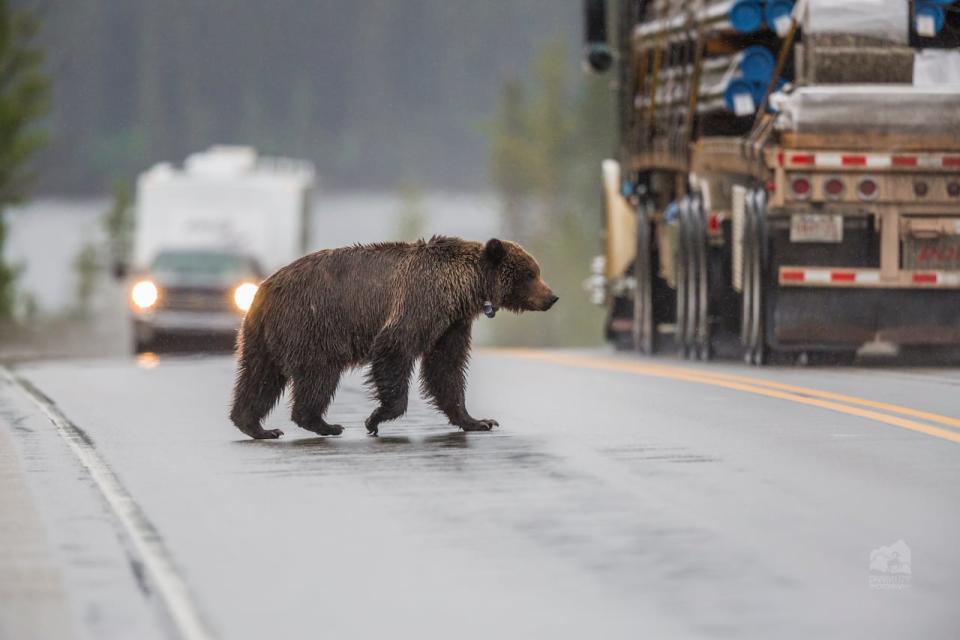 British Columbia’s Elk Valley is a grim place to be a grizzly bear, according to a new report that shows recorded conflicts and mortality rates are higher in the region than anywhere else in the province.
British Columbia’s Elk Valley is a grim place to be a grizzly bear, according to a new report that shows recorded conflicts and mortality rates are higher in the region than anywhere else in the province.
The report, published in September in Conservation Science and Practice, was conducted by a team of researchers led by Colin Lamb, a wildlife scientist with Biodiversity Pathways and the University of British Columbia. The team tracked 76 grizzly bears in the region between 2016 and 2022 and the data reveals some stark findings.
The 5,073-square-kilometre study area, located in the Rocky Mountains of southeastern B.C., accounts for less than one per cent of grizzly-bear range in the province — yet report data shows it is where 33 per cent of bear deaths involving vehicles happen, and 42 per cent of deaths involving trains.
While adult bears seem to be faring fine with survival rates of 95 per cent, sub-adult grizzly bears — ages two to six — have the lowest survival rates in North America, with up to 40 per cent annual mortality.
“These young naive bears are navigating a pretty challenging landscape. They get struck accidentally and then there’s a lot of collisions or conflicts with with people. And as a result we have this population that basically is not self-sustaining,” said Lamb, speaking to CBC’s Daybreak South.
Lambsaid the population is not waning because bears are constantly immigrating to the area as the valley has abundant food sources, but for the local population to be sustained, efforts need to be made to reduce collisions and human conflict.
Vehicle collisions, conflict with people are primary causes
Of the 76 bears tracked, the primary cause of death was either collisions with vehicles or trains or conflict with people due to unsecured attractants such as livestock, fruit and garbage on private property.
Of 22 bears that died during the study, 14 had functioning radio collars on when they were killed, allowing researchers to identify their cause of death.
Twelve of those were due to collisions or conflict; one’s cause of death is unknown but suspected to be human-caused, and one was natural.
Of the 13 likely killed by people, seven were not reported to authorities.

Clayton Lamb with the University of British Columbia says efforts need to be made to reduce collisions and human conflict for the local bear population to be sustained. (Laura Smit)
Report authors estimate only about one-third of human-caused mortalities not involving conservation officers are reported to authorities.
“Grizzly bear mortality in the Elk Valley due to collisions and conflicts with people is an order of magnitude greater than elsewhere in British Columbia,” reads the report.
In Elk Valley, there was an average of 65.3 conflicts between bears and people per 10,000 square kilometres per year, compared to less than six across the rest of B.C.
The report concludes that efforts must be made to keep both bears and people safer in the valley.
Tools suggested include bear-aware training for people in the area, as well as securing attractants and maintaining electric fences.
One grizzly was killed by a landowner while she was attacking their pigs, according to the report.The landowner had an electric fence but it had shorted out because vegetation was growing up against it.
For its part, the B.C. government broke ground in 2020 on an infrastructure project that aims to fence 27 kilometres of Highway 3 and create wildlife crossings. The report shows crossing structures are used regularly by bears in Banff National Park and, when combined with fencing, can reduce wildlife mortality by up to 96 per cent.
CBC reached out to the Ministry of Transportation for details on that project and when completion is expected. The ministry did not respond by deadline.
*****
Credit belongs to : ca.news.yahoo.com
 Atin Ito First Filipino Community Newspaper in Ontario
Atin Ito First Filipino Community Newspaper in Ontario






